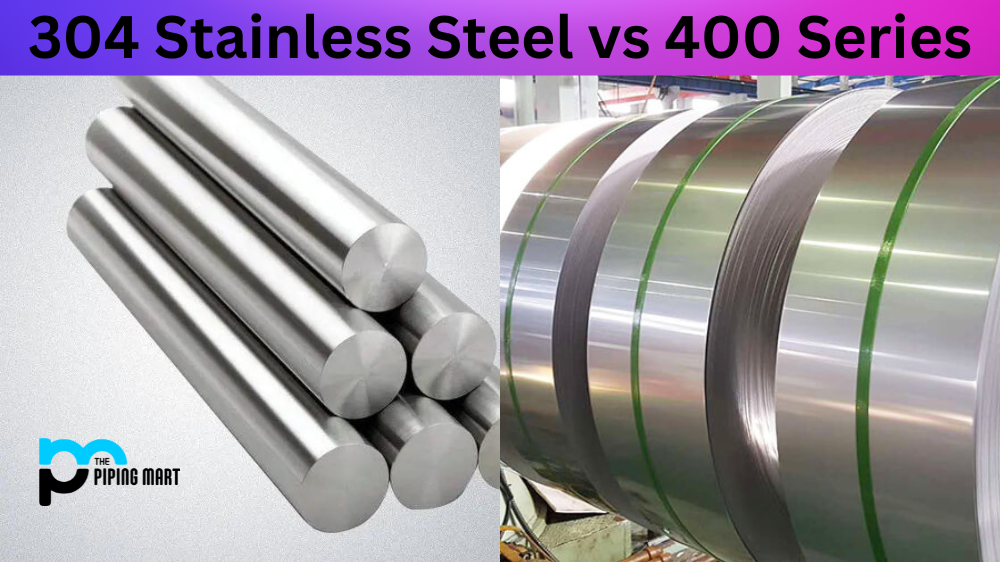If you’ve ever shopped for stainless steel products, you’ve likely heard of the two most common grades of stainless steel available – 400 series and 304. But what do these grades mean, and how do they differ from one another? In this blog post, we will dive into the differences between 400 series and 304 stainless steel to help you make an informed decision when shopping for products made with either material.
400 Series Stainless Steel
The 400 series of stainless steel is known for its hardness as well as its resistance to corrosion. This grade of stainless is often used in applications such as cutlery, kitchen supplies, and appliances that require a high level of durability. Additionally, it is commonly used in automotive parts due to its ability to resist wear and tear over time.
What makes 400 series stainless distinct from other types is the presence of nickel in its composition. This addition makes it more ductile than other types of stainless steel, allowing it to be bent without breaking or cracking. The nickel content also adds strength and helps prevent rusting or pitting over time. That being said, 400 series stainless is still not quite as resistant to corrosion as 304 stainless due to its slightly higher carbon content.
304 Stainless Steel
304 stainless steel has long been one of the most popular grades available due to its combination of strength and corrosion resistance. It contains 8-10% nickel which helps make it more resistant to rusting than other grades like 410 or 430. It also has a low carbon content which helps reduce the risk of corrosion over time. With proper maintenance and care, 304 can last for years without showing any signs of wear or rusting.
It is important to note that while 304 may be more expensive than other types of stainless steel, it offers superior performance and longevity that can save you money in the long run by reducing the need for repairs or replacements down the line.
Difference Between 304 Stainless Steel and 400 Series
Composition
One of the primary differences between stainless steel 304 and 410 is their composition. Stainless steel 304 contains 18% chromium and 8% nickel, while stainless steel 410 contains 13% chromium and only 0.5% nickel. This difference in composition gives each type of stainless steel different properties and applications.
Corrosion Resistance
Stainless steel 304 is more corrosion-resistant than stainless steel 410. This is due to the higher levels of chromium in stainless steel 304, which forms a protective layer on the surface of the metal that prevents rust and other forms of corrosion. Stainless steel 410 is less corrosion-resistant than stainless steel 304, but it is still able to resist most types of corrosion if it is properly maintained.
Strength
Stainless steel 304 is also stronger than stainless steel 410. This is due to the higher levels of chromium and nickel in stainless steel 304, which add to its overall strength. Stainless steel 410 is not as strong as stainless steel 304, but it still has good strength for most applications.
Temperature Resistance
Both stainless steel 304 and 410 are able to resist high temperatures without losing their structural integrity. However, stainless steel 304 is better able to resist high temperatures than stainless steel 410. This is due to the higher levels of chromium in stainless steel 304, which allows it to maintain its structure at higher temperatures better than stainless steel 410.
Cost
Stainless steel 304 is typically more expensive than stainless steel 410. This is due to the higher levels of chromium and nickel in stainless steel 304, which make it more expensive to produce. Stainless steel 410 is typically less expensive than stainless steel 304, but it may not be available in all sizes and grades.
Conclusion:
When shopping for products made with either type of stainless steel, there are a few things you should consider before making your purchase. First, consider your budget – if cost is an issue, then the 400 series may be a better option since it tends to be less expensive than the 304. If durability is your main concern, go with 304; while not as hard as the 400 series, it offers superior corrosion resistance, which means fewer repairs or replacements over time. Ultimately, whichever type you choose depends on your individual needs, but understanding the difference between them can help make sure you get exactly what you’re looking for out of your purchase!

Pipingmart is a B2B portal that specializes in metal, industrial and piping items. Additionally, we share the latest information and information about materials, products and various types of grades to assist businesses that are involved in this business.




